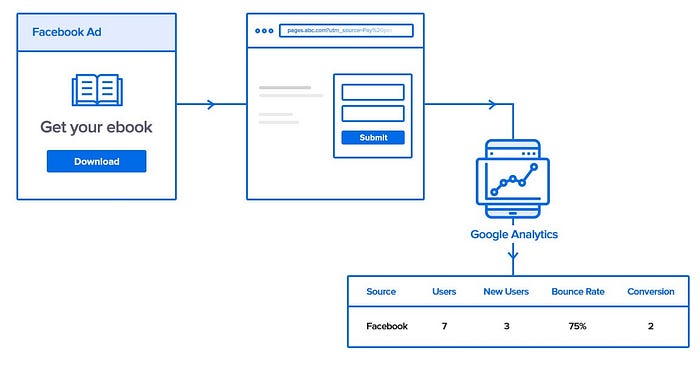What is UTM Tracking? A Comprehensive Guide to Understanding and Using UTM Tracking

Introduction to UTM Tracking
Have you ever wondered how marketers know exactly which campaigns are driving the most traffic and sales? The answer lies in UTM tracking, a vital tool for anyone involved in digital marketing. Whether you’re running social media campaigns, email marketing, or paid ads, UTM tracking empowers you to measure performance with precision.
In this blog, we’ll dive into what UTM tracking is, how it works, and why it’s a game-changer for businesses.
What is UTM Tracking?
UTM tracking refers to the process of using UTM (Urchin Tracking Module) parameters to track the performance of specific links in your digital marketing campaigns.
These UTM parameters are small snippets of code added to the end of a URL. They help marketers identify the source of website traffic and determine which marketing efforts are most effective. For instance: plaintexCopy cod
https://yourwebsite.com?utm_source=facebook&utm_medium=social&utm_campaign=summer_saleIn the example above, the UTM parameters tell you that the user came from a Facebook social media campaign called “summer_sale.”

Why UTM Tracking is Crucial for Marketers
Marketing success depends on data, and UTM tracking is one of the most effective ways to gather that data. Without UTM parameters, it’s almost impossible to pinpoint the exact source of your traffic. Here’s why UTM tracking matters:
- Attribution Accuracy: Understand which channels are driving traffic and conversions.
- Campaign Optimization: Identify high-performing campaigns and adjust budgets or strategies accordingly.
- Data-Driven Decisions: Make informed decisions backed by hard numbers.
How UTM Parameters Work
The 5 Core UTM Parameters
- utm_source: Identifies the source of traffic (e.g., Facebook, Google, newsletter).
- utm_medium: Specifies the marketing medium (e.g., social, email, paid_search).
- utm_campaign: Tracks the name of the campaign (e.g., winter_sale, product_launch).
- utm_term: Used for paid search campaigns to identify keywords.
- utm_content: Differentiates between similar ads or links in the same campaign.

Example of a UTM-Tagged URL
Here’s how UTM tags look in action:
https://yourwebsite.com?utm_source=google&utm_medium=paid_search&utm_campaign=holiday_sale&utm_term=discount_code&utm_content=cta_buttonThis link provides detailed information about the traffic source, the medium, and even the specific call-to-action clicked by the user.
Benefits of UTM Tracking
- Better ROI Measurement: Understand the effectiveness of each campaign.
- Improved Budget Allocation: Focus on the most successful channels.
- Enhanced Audience Insights: Learn more about how users engage with your content.
- Seamless Reporting: Make analytics clearer and easier to understand.

Common Use Cases for UTM Tracking
1. Social Media Campaigns
UTM tags help track clicks from social platforms like Facebook, Instagram, and LinkedIn. You can measure the performance of organic vs. paid posts.
2. Email Marketing
When sending newsletters, you can use UTM tags to track clicks on various links within the email and measure engagement.
3. Paid Ads
Track clicks from Google Ads, Facebook Ads, or other paid campaigns to evaluate performance and cost-effectiveness.
4. Influencer Marketing
Use UTM tags to monitor traffic from influencer collaborations, ensuring you know which partnerships deliver the best ROI.
How to Create UTM Tags
Manual Tagging
You can manually add UTM parameters to your URLs. This requires knowledge of the UTM structure and proper syntax.
Using a UTM Builder
Tools like Google UTM Builder , Teamcamp UTM Builder etc.simplify the process. These tools provide an interface to input UTM details and automatically generate a tagged URL.

Best Practices for UTM Tracking
- Keep it Consistent: Use a standardized naming convention across all campaigns.
- Limit Parameters: Focus on the essentials to avoid cluttered URLs.
- Test Links: Verify that your tagged URLs work correctly and collect data accurately.
- Use Shortened Links: After tagging, shorten URLs with tools like Bitly for a cleaner look.
- Integrate with Analytics Tools: Ensure your analytics platform can read and interpret UTM data.
Common Mistakes to Avoid in UTM Tracking
- Using Spaces in Tags: Replace spaces with underscores or hyphens to avoid errors.
- Overloading URLs: Including unnecessary parameters can complicate data analysis.
- Tracking Internal Links: UTM tags are meant for external campaigns, not internal navigation.
- Inconsistent Tagging: Inconsistent tags lead to fragmented data.

Top Tools for UTM Tracking
- Teamcamp UTM Builder: A user-friendly tool for creating and managing UTM tags with accuracy.
- Google Analytics: Integrates seamlessly with UTM parameters for detailed campaign insights.
- Bitly: A URL shortener that works well with UTM-tagged links.
Conclusion
UTM tracking is a vital practice for any marketer aiming to understand and optimize their campaigns. By adding UTM parameters to your URLs, you gain valuable insights into traffic sources, user behavior, and campaign performance.
Whether you’re a seasoned marketer or just starting, tools like Teamcamp UTM Builder can streamline the process, ensuring you collect accurate data without the hassle. Start tagging your links today and unlock the full potential of your marketing campaigns!
FAQs
1. What is UTM tracking used for?
UTM tracking is used to measure the performance of specific marketing campaigns by analyzing the traffic generated through tagged URLs.
2. Can I create UTM tags manually?
Yes, you can create UTM tags manually, but using tools like Teamcamp UTM Builder ensures accuracy and saves time.
3. Are UTM tags compatible with all analytics platforms?
Most analytics platforms, including Google Analytics, can interpret UTM tags seamlessly.
4. Do UTM tags impact SEO?
No, UTM tags do not affect SEO rankings since they are used only for tracking purposes.
5. What’s the best tool for UTM tracking?
Tools like Teamcamp UTM Builder offer an easy and reliable way to create and manage UTM tags for all your campaigns.

Comments
Post a Comment